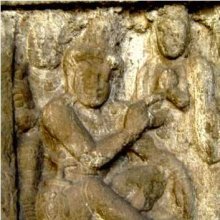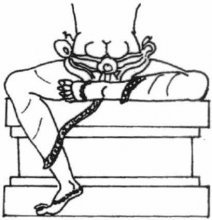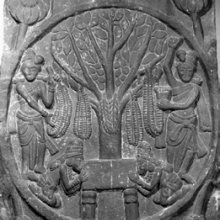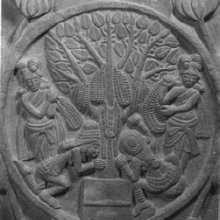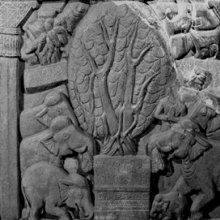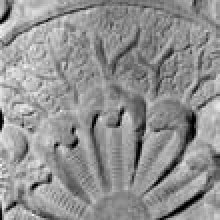Seat, Seated: 3 definitions
Introduction:
Seat means something in Hinduism, Sanskrit, the history of ancient India. If you want to know the exact meaning, history, etymology or English translation of this term then check out the descriptions on this page. Add your comment or reference to a book if you want to contribute to this summary article.
Images (photo gallery)
(+262 more images available)
In Hinduism
Yoga (school of philosophy)
Source: ORA: Amanaska (king of all yogas): A Critical Edition and Annotated Translation by Jason BirchThe Seat (i.e., Yoga pose) is denoted by the Sanskrit term Āsana, according to the Amanaska Yoga treatise dealing with meditation, absorption, yogic powers and liberation.—Accordingly, as Īśvara says to Vāmadeva: “[...] [Now], I will teach the practice of that, which produces absorption. Seated (sukha-sanniviṣṭa) comfortably in a solitary place on an even seat (sama-āsana), having been supported a little from behind, the gaze [held] steady at an arm’s length, the limbs relaxed and free from worry, do the practice. [...]”.

Yoga is originally considered a branch of Hindu philosophy (astika), but both ancient and modern Yoga combine the physical, mental and spiritual. Yoga teaches various physical techniques also known as āsanas (postures), used for various purposes (eg., meditation, contemplation, relaxation).
India history and geography
Source: Singhi Jain Series: Ratnaprabha-suri’s Kuvalayamala-katha (history)Seats and Coverlets were spread in order to beautify the Sleeping chamber (of young ladies) in Ancient India, as depicted in the Kathās (narrative poems) such as Uddyotanasūri in his 8th-century Kuvalayamālā (a Prakrit Campū, similar to Kāvya poetry).—The Kuvalayamala (779 A.D.) is full of cultural material which gains in value because of the firm date of its composition. [...] Page 83.3-9: Here is the description of the house or the sleeping chambers of young ladies which were beautified for the reception of their husbands. The select items in this list are as follows: [e.g., spreading of coverlets and seats in the jāla-gavākṣa (airel windows);] [...]

The history of India traces the identification of countries, villages, towns and other regions of India, as well as mythology, zoology, royal dynasties, rulers, tribes, local festivities and traditions and regional languages. Ancient India enjoyed religious freedom and encourages the path of Dharma, a concept common to Buddhism, Hinduism, and Jainism.
See also (Relevant definitions)
Starts with: Lotus seat, Seated posture.
Ends with: Comfortable seat, Even seat, Lotus seat, Yogic posture.
Full-text (+5715): Asana, Upavishta, Pitha, Simhasana, Padmasana, Sukhasina, Asina, Nivishta, Sukhopavishta, Adhyasita, Nishannaka, Sukhasana, Ardhasana, Rajasana, Asinapracalayita, Ayatana, Bhadrasana, Supavishta, Mundasana, Dharmasana.
Relevant text
Search found 402 books and stories containing Seat, Seated; (plurals include: Seats, Seateds). You can also click to the full overview containing English textual excerpts. Below are direct links for the most relevant articles:
Manusmriti with the Commentary of Medhatithi (by Ganganatha Jha)
Verse 3.208 < [Section XIV - Method of Feeding]
Verse 7.220 < [Section XVI - Subsequent Routine]
Verse 2.119 < [Section XXIII - Rules regarding Salutation]
Mahabharata (English) (by Kisari Mohan Ganguli)
Section XCIV < [Bhagavat-Yana Parva]
Section XLI < [Rajadharmanusasana Parva]
Section IV < [Pauloma Parva]
The Gospel of Buddha (by Paul Carus)
Chapter 91 - The Courtesan Ambapali
Chapter 89 - The Visit To Pataliputta
Trishashti Shalaka Purusha Caritra (by Helen M. Johnson)
Part 4: Birth-rites of Śānti < [Chapter V - Twelfth incarnation as Śānti]
Part 11: The name-giving festival < [Chapter II - Birth of Ajita and Sagara]
Part 2: The fourteen dreams of Vijayā < [Chapter II - Birth of Ajita and Sagara]
Victim < [October – December, 2000]
The Working Classes and the Future Constitution < [September-October 1933]
Gokak’s Ministry of letters < [July – September 1991]
Harivamsha Purana (by Manmatha Nath Dutt)
Chapter 51 - Kaishika Worships Krishna < [Book 2 - Vishnu Parva]
Chapter 101 - Krishna Invites a meeting of His Kinsmen < [Book 2 - Vishnu Parva]
Chapter 1 - Kamsa Is Informed of His Death by Narada < [Book 2 - Vishnu Parva]
Related products
(+2 more products available)
